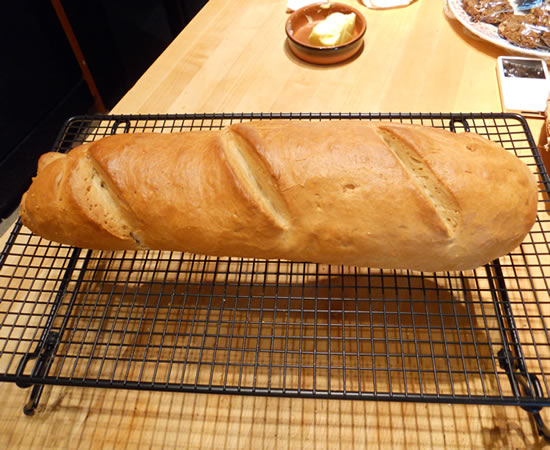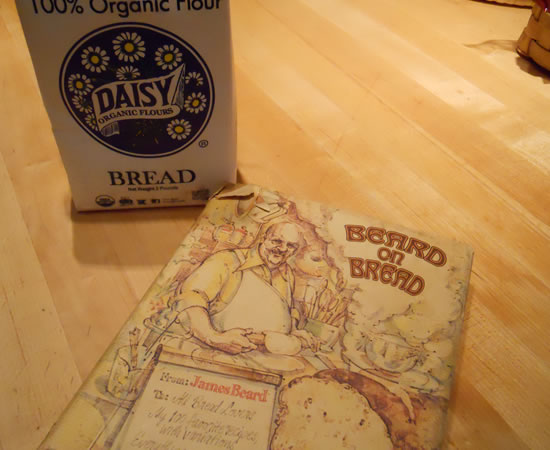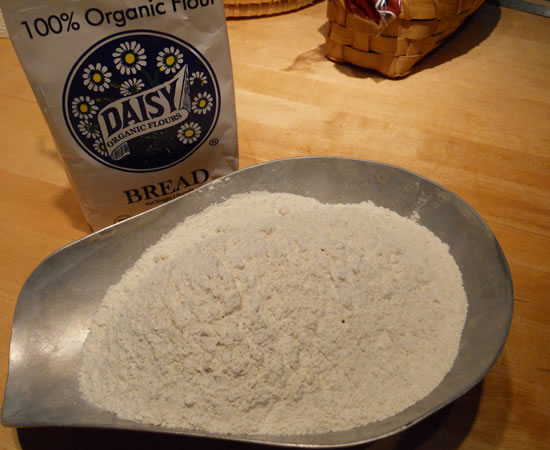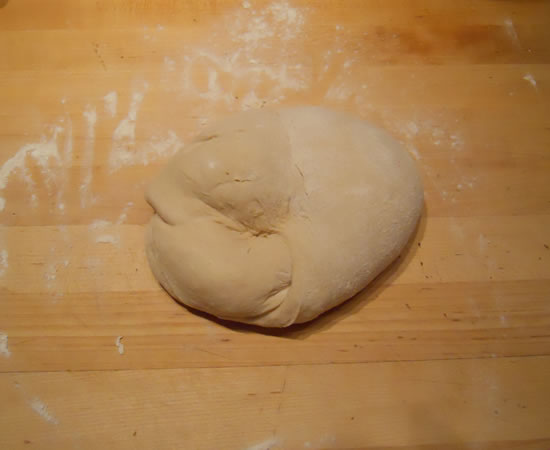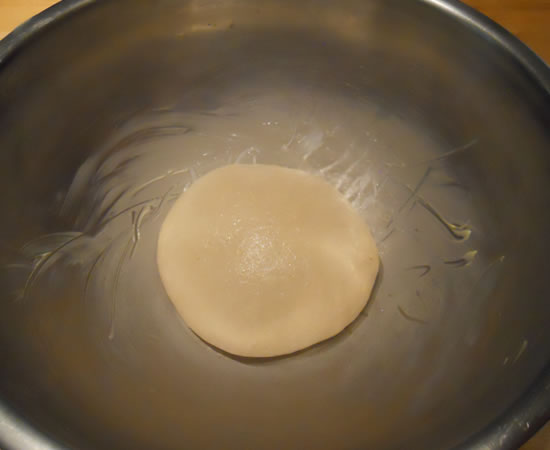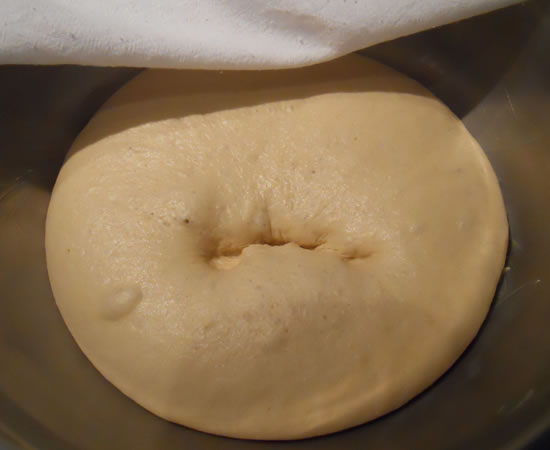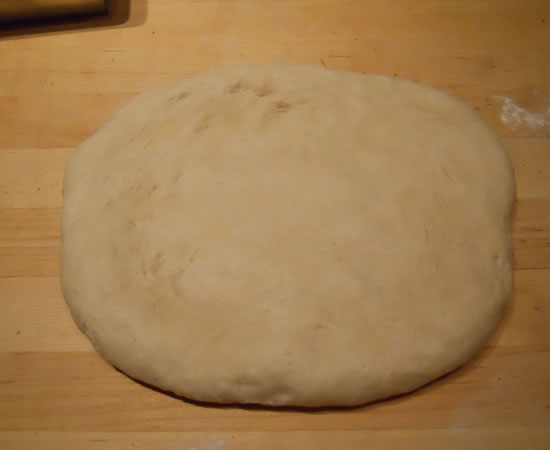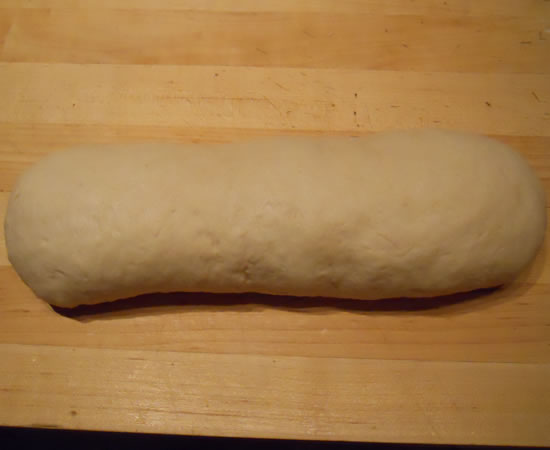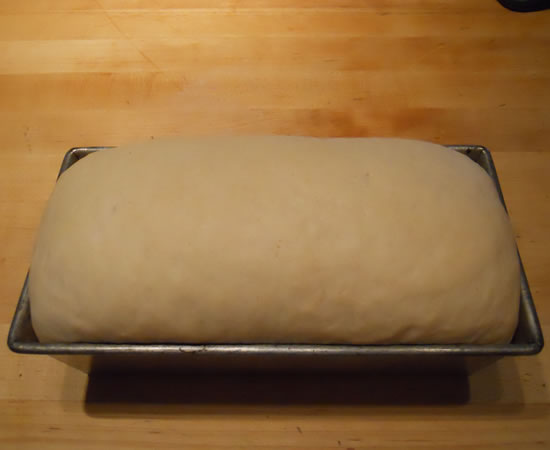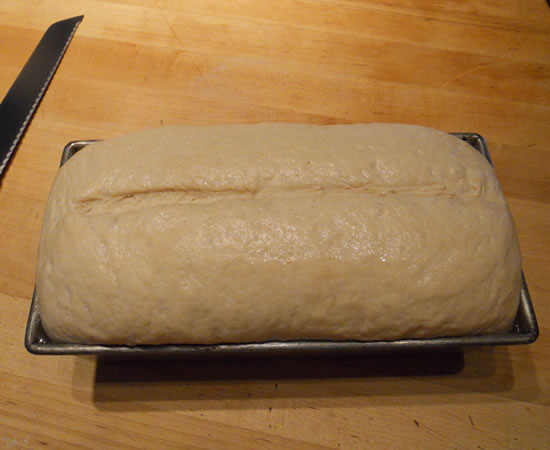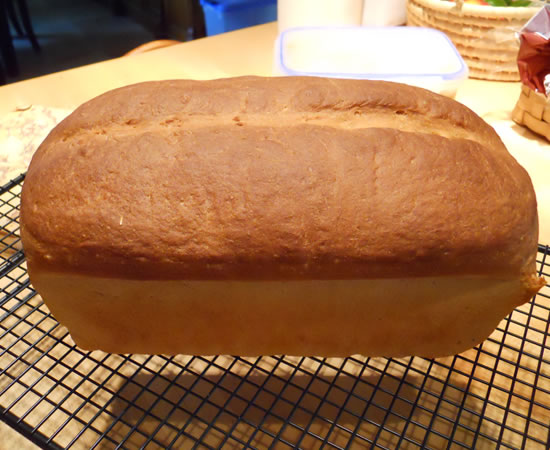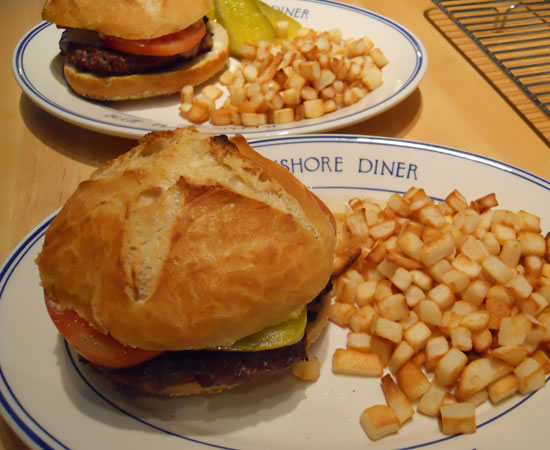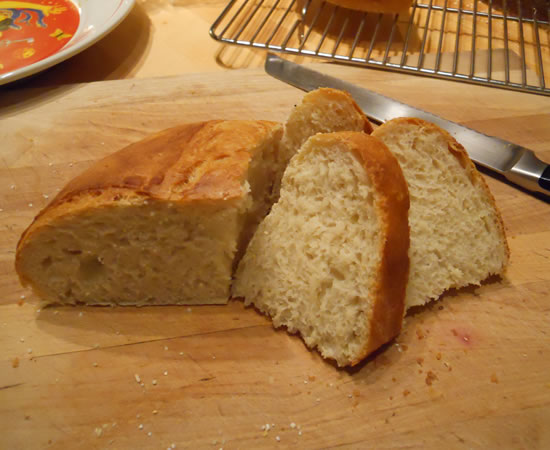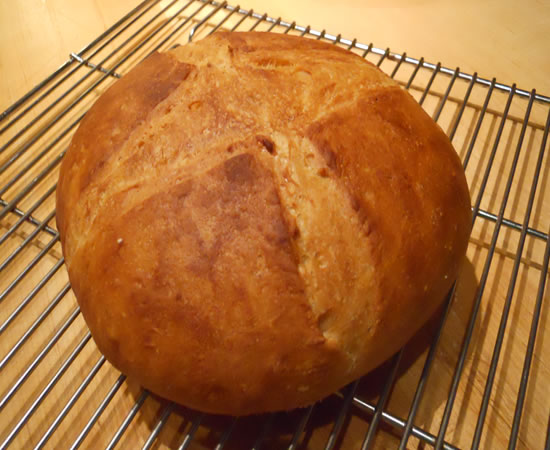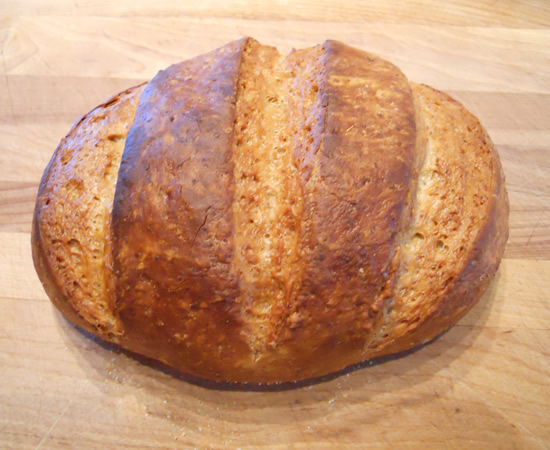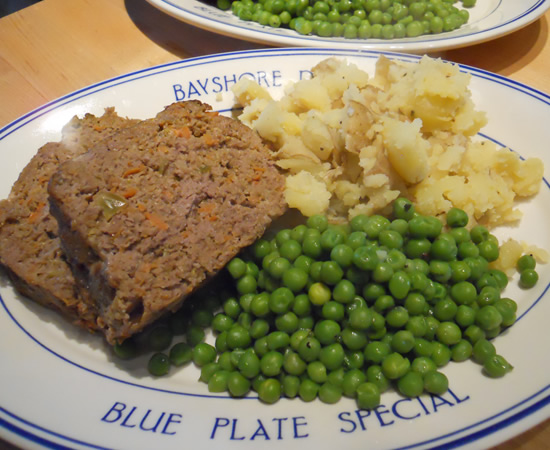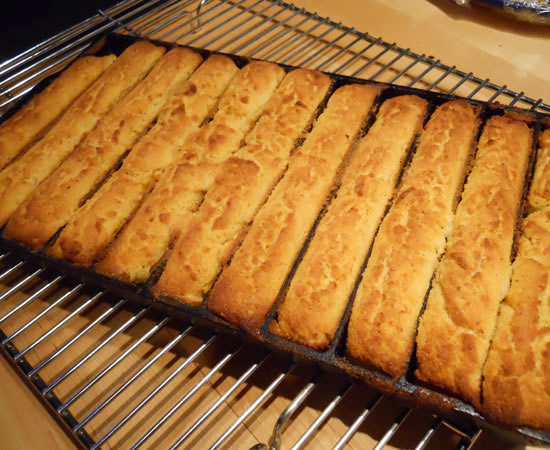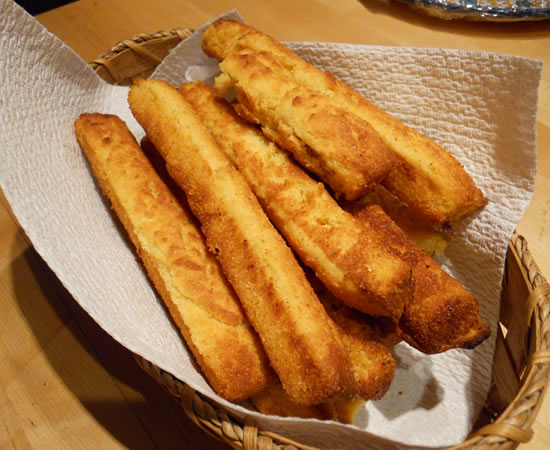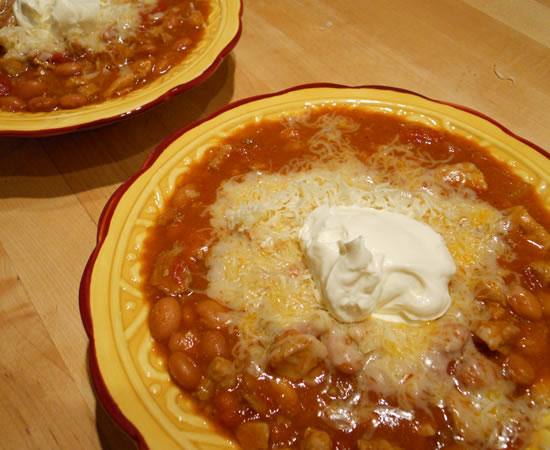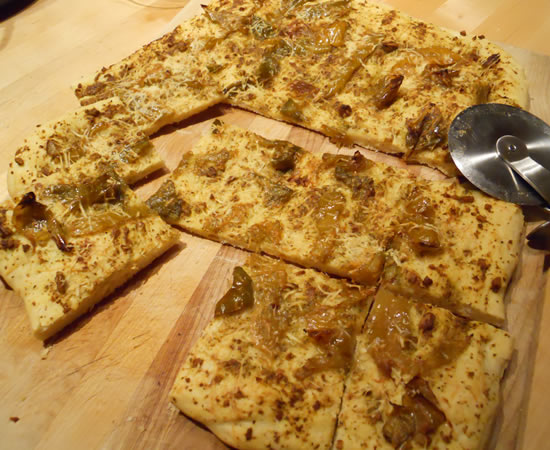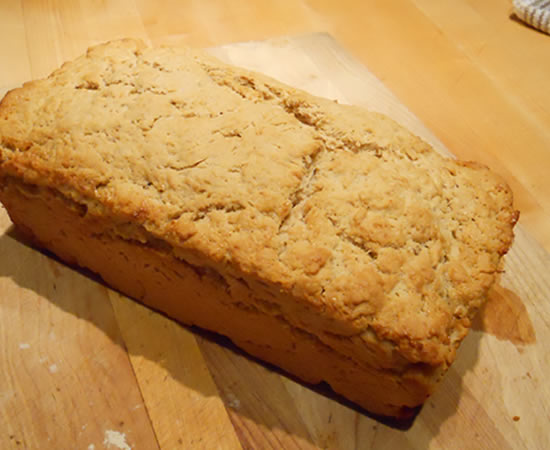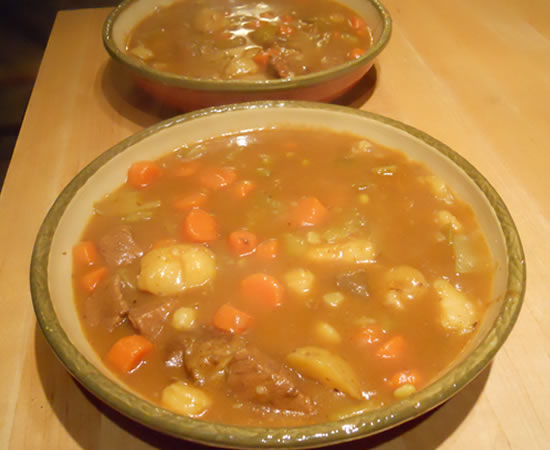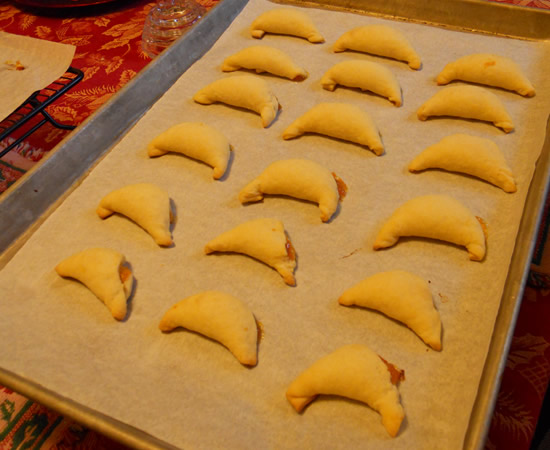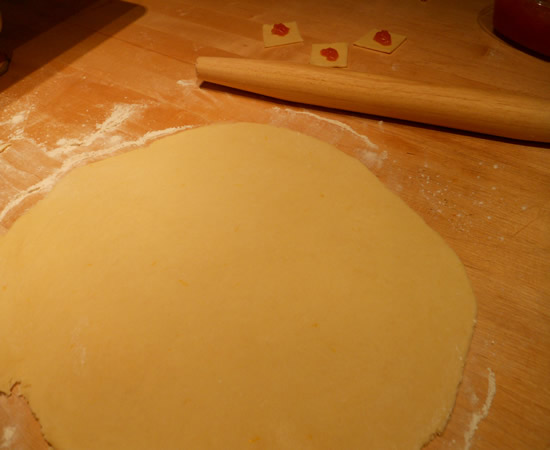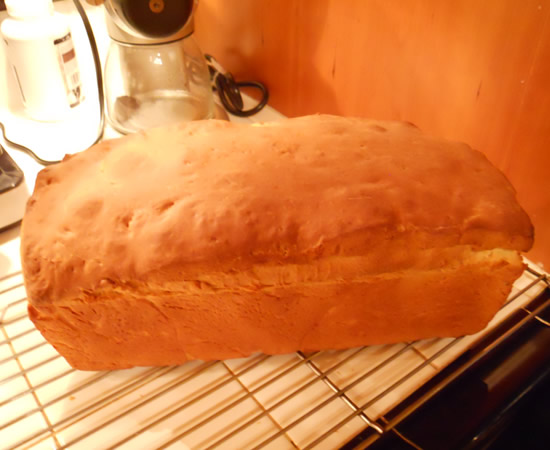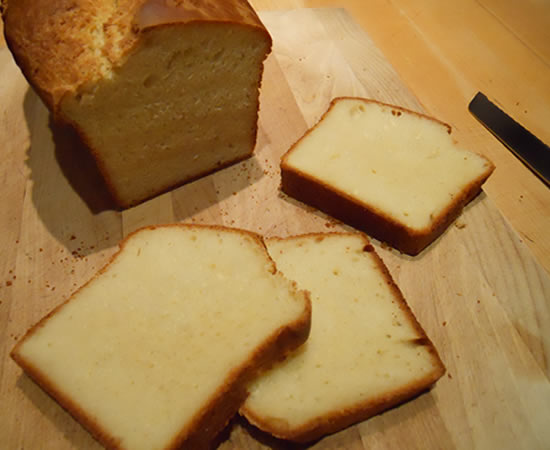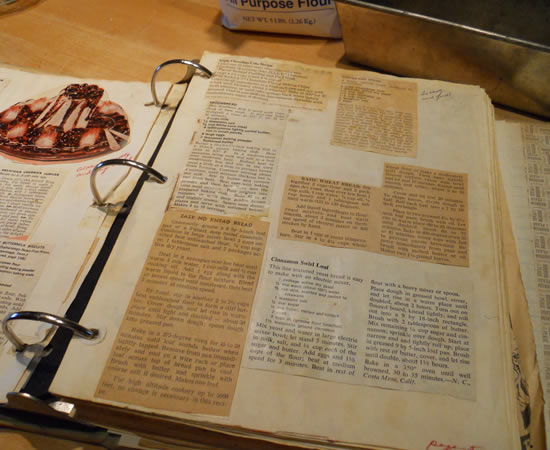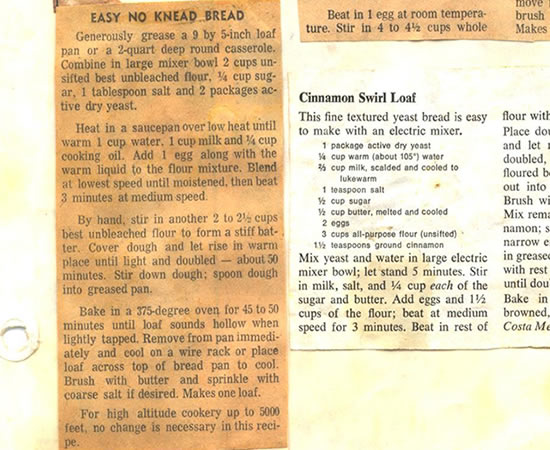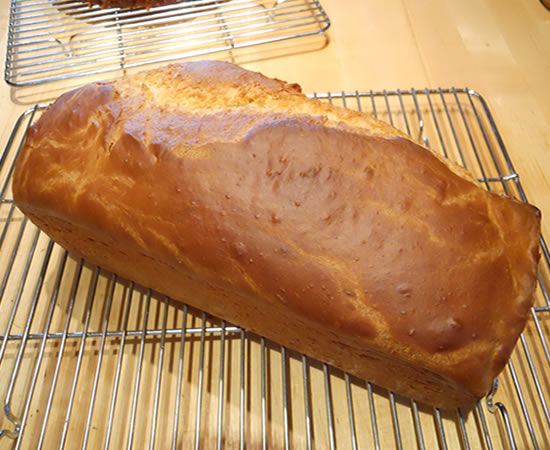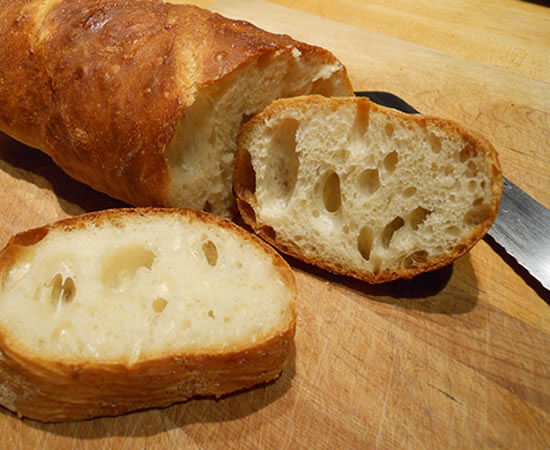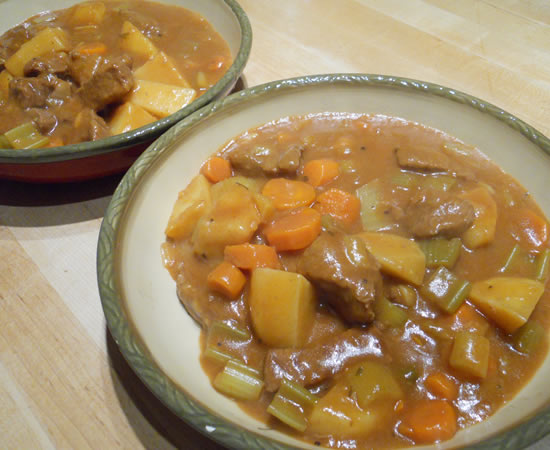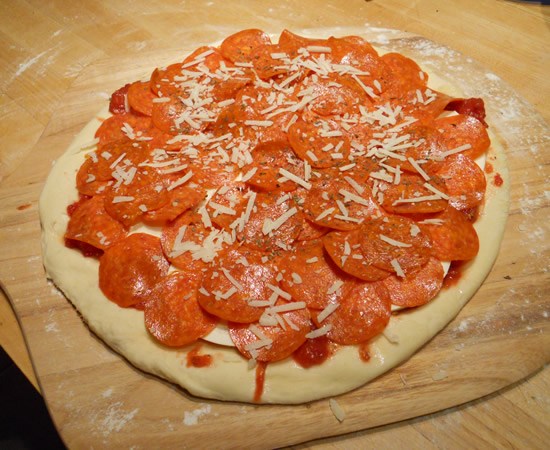Fresh Bread and Beef Stew
I'm still baking bread - and loving every loaf of it. This is a James Beard bread that only takes a couple of hours from start-to-finish. There is no second rise. The loaf is formed and it goes right into a cold oven.
It's magic.
It's also really good. Great texture and a really crunchy crust. I'm still using the Daisy Organic Flour.
I'm loving it!
James Beard French-Style Bread
- 1 1/2 pk active dry yeast
- 1 tbsp sugar
- 2 cups warm water (100-115 deg.)
- 1 tbsp salt
- 5-6 cups all-purpose or hard wheat flour
- 3 tbsp Yellow cornmeal
- 1 egg white mixed with 1 tbsp cold water
Combine the yeast with sugar and warm water in a large bowl and allow to proof. Mix the salt with the flour and add to the yeast mixture, a cup at a time, until you have a stiff dough.
Remove to a lightly floured board and knead until no longer sticky, about 10 minutes, adding flour as necessary.
Place in a buttered bowl and turn to coat the surface with butter. Cover and let rise in a warm place until doubled in bulk..1 1/2-2 hrs.
Punch down the dough. Turn out on a floured board and shape into two long, French bread-style loaves. Place on a baking sheet that has been sprinkled with the cornmeal, but NOT buttered.
Slash the tops of the loaves diagonally in two or three places with a single edge razor blade or sharp knife, brush the loaves with the egg white wash.
Place in a COLD oven, set the temperature at 400° and bake 35 minutes, or until well browned and hollow sounding when the tops are tapped.
I cut the recipe in half and just make one loaf at a time. This is a serious one-day bread. It does not like being around more than that. But it makes great bread crumbs!
But it does like getting slathered in butter and then dipped into a big bowl of beef stew! I like it, too!
Stew is stew. I don't have a recipe. I just make it.
Beard on Bread
When the Daisy flour arrived last week I knew I was going to have some fun with it.
Baking and I go well together. I love homemade breads, pastries, cakes, cookies, pies... All that good stuff. And if you're going to take the time to do it - use quality ingredients and make the time to do it right.
Coming up with my first loaf of bread, though, presented a bit of a challenge. My first instinct was to make an artisan-type bread. Something rustic and crusty (kinda like me.) In the end, though, I thought a classic white loaf was really where I should begin - and that meant James Beard.
James Beard has been my culinary hero since day two. (Julia Child came first.) I love the introduction to his 1959 cook book - a recipe for boiling water. He taught the basics and then used them to build more complex recipes. In his 1973 Beard on Bread, he demystified bread-making for a generation that was raised on Wonder Bread.
It was to this tome I turned for my first loaf. I've made the Basic White Bread many times. It really is a quick and easy loaf and pretty foolproof. As with most of Beard's recipes, you really have to work at screwing it up.
The recipe below is verbatim from the 1973 cook book. It is long and detailed as his instructional recipes generally are. His subsequent recipes assume the reader has read and understands the basics and he does not repeat himself. The beauty of his cook books and recipes is that he actually explains why something happens and how to compensate for the variables of things such as weather and ingredients. Anyone can cook if they pay attention.
Basic White Bread
This is my idea of a good, simple loaf of bread—firm, honest in flavor, tender to the bite yet with a slight chewiness in the crust, and excellent for toast. The ingredients are just flour, water, salt, and yeast, with the addition of a little sugar. It is a recipe I use constantly, although I vary it from time to time, and I have chosen it as my first recipe here because I think it will provide any beginner with the basic techniques of breadmaking. In fact, it is one I have taught to my pupils through the years. Once you have mastered the procedures given here, you can go on to more complex recipes without difficulty.
As I have said in the introductory observations, there are many variables in breadmaking. As far as flours are concerned, for example, since I know that the hard wheat flour producing the best results in wheat breads is not always easy to come by, in this recipe we’ll use a common unbleached (or bleached) all-purpose flour. And since compressed yeast is often difficult to find and the dry variety is available everywhere, throughout this book we’ll use “active dry yeast” and refer to the measure by package, although occasionally I will suggest the alternative of compressed yeast, since many people enjoy working with it. Some breads call for milk or fruit juice; some, like this one, are made with water. The salt content of bread is adjustable too: I use a rule of thumb of 1 tablespoon for each pound (3¾ cups) of flour; you may alter this to your own taste. There are several ways to knead dough, several ways to shape it into a loaf, and it can be given one or more risings. There is also a choice of washes you can use on the loaf before it goes into the oven, and you can slash the top in different styles or leave it as it is. Even the weather has an effect on breadmaking. The degree of humidity and warmth will govern the absorption quality of the flour and the action of the yeast.
Here, in this first recipe, we’ll reduce decisions to a minimum and put all of these extra factors into footnotes. You should be able to make this loaf successfully the first time around without referring to a single one of the notes. But they will come in handy as you vary ingredients and develop your own style of baking. For instance, if you have small hands, you will probably prefer to use two hands for kneading. The approach to making every loaf of bread is essentially the same, and for that reason you should implicitly have this recipe in mind throughout the rest of the book, as I will not keep spelling out fundamental procedures, such as how to proof or how to knead.
Yield : 1 large loaf or two smaller loaves
Ingredients
- 1 package active dry yeast
- 1½ to 2 cups warm water (l00° to 115°, approximately)
- 2 teaspoons granulated sugar
- 3¾ to 4 cups all-purpose flour (approximately 1 pound)
- 1 tablespoon salt
- 1½ to 2 tablespoons softened butter for buttering bowl and pan
Directions
First, proof the yeast, which means testing it to make sure it is still active. To do this, pour the contents of the package into ½ cup of the warm water (about 100° to 115°), add the sugar, stir well, and set aside. After a few minutes the fermentation of the yeast will become apparent as the mixture swells and small bubbles appear here and there on the surface.
1. While the yeast is proofing, measure 3¾ cups unsifted flour into a 2- to 3-quart bowl with rounded sides. (Save the other ¼ cup flour for kneading, if necessary.) Add the tablespoon of salt and blend well.
2. Pour approximately ¾ cup warm waters into the flour and stir it in with a wooden spoon or with your hands. Add the yeast mixture, and continue stirring until the ingredients are thoroughly blended and tend to form a ball that breaks away from the sides of the bowl. (If the dough is very stiff, add a tiny bit more water.) Transfer the dough to a lightly floured marble slab, bread board, or counter top.
3. Now begin the kneading process, which evenly distributes the fermenting yeast cells through the dough. There are several ways to knead,4 but I prefer this one-handed method: Sprinkle the dough lightly with flour and also flour your working hand. Push the heel of your hand down into the dough and away from you. Fold the dough over, give it a quarter turn, and push again with the hand. Continue the sequence of pushing, folding, and turning until it becomes a rhythmic motion. Knead until the dough no longer feels sticky and has a smooth, satiny, elastic texture, adding more flour, if necessary; this will take anywhere from 4 to 10 minutes, depending on the character of the flour and the warmth and humidity of the room. To test whether the dough has been kneaded enough, make an indentation in it with your fingers; it should spring back. Sometimes blisters will form on the surface of the dough and break, which is another sign that the kneading is sufficient.
4. When the dough has reached the consistency described above—with experience you will know what this means by the feel of it—it is ready for the first rising. (Rising allows the fermenting yeast to produce tiny bubbles of carbon dioxide, which stretches the gluten in the flour and thus leavens the bread.) First, rest the dough on the board for several minutes. Meanwhile, wash out the mixing bowl; dry it, and rub it with 1 to l½ tablespoons of softened butter.
5. Place the ball of dough in the bowl, and roll it around so that it becomes completely coated with butter. (This will keep the surface from drying out and cracking as the dough rises.) Cover the bowl with a piece of plastic wrap or foil or with a towel and set in a warm, draft-free place. (The term “draft-free,” which you will encounter repeatedly, is used because the yeast must be pampered with constant warmth to keep it active.) Find a protected corner or shelf, or use a cool oven (it won’t hurt if the pilot light is on). Allow the dough to double in bulk, which will take about 1 to 2 hours.
It is difficult for a beginner to tell when dough has actually doubled in volume, but the increase is dramatically more than one might expect. You can get the idea best by pouring 4 cups of water into the empty bowl (before it has been greased) and then pouring in the same amount again, noting how high up the water comes. Fortunately there is another, surer test to show when the dough is properly risen. When it looks ready, simply make an indentation in it with two fingers. If the dough does not spring back, then it is ready. It will not hurt should it rise a little too much, but excessive rising will affect the flavor and texture of the finished bread. If for some reason you must prolong a rising, place the bowl of dough in the refrigerator to slow down the action of the yeast.
The dough must now undergo a second rising, which will take place in the baking pan. Thoroughly butter one or two heavily tinned loaf pans.
6. Then remove the cover from the bowl and deflate the dough by pushing down into it with your fist. Transfer it to a floured board, knead it rather well for about 3 minutes, then pat it into a smooth round or oval shape. Let it rest for 4 to 5 minutes, then form it into a loaf about 8 inches long and 3 inches wide.
7. Lift it carefully, drop it into the loaf pan, and smooth it out.Cover the loaf pan, as you did the bowl, and set it in a warm, draft-free place to double in bulk, at which point the loaf will have risen slightly above the edge of the pan. The second rising will take anywhere from 40 minutes to 1¼ hours, according to the warmth of the room and the way you have worked the dough. Don’t rush the process, and watch the dough carefully. Meanwhile, set the oven for 400°.
8. There are various ways to treat the loaf before it goes into the oven. For this recipe, merely brush the dough with cold water, which helps to give the top a textured crust.
9 Then, with a sharp knife make three diagonal slashes about ½ inch deep across the top of the loaf, both for a more professional look and to prevent cracking.
10 Place the pan near the center of the lower oven rack and set a timer for 35 minutes. Begin testing after that time, even though the total baking time may be as much as 50 minutes. To test, rap the top of the loaf with your knuckles. When done, it will sound hollow. Invert the loaf onto a towel held in one hand and test the bottom as well for that hollow sound. If it does not seem quite firm enough and needs only a little more baking, place the loaf directly on the oven rack to crisp the bottom, watching it carefully to prevent it from burning. If the test shows that the bottom is somewhat soft, slide the loaf back into the heated pan and return it to the oven to bake for 5 or 6 minutes more. Test the bottom again, and when firm enough, bake the unmolded loaf a few minutes for the final crisping. When completely baked, remove from the oven and set on a bread rack to cool.
After 2 or 3 hours the bread is good for slicing. When it is thoroughly cooled it can be stored in a plastic bag, in or out of the refrigerator, for several days. It also freezes well, and a frozen loaf, wrapped airtight, can be stored for a month. To reheat, remove from the freezer, wrap in aluminum foil, and heat in a 350° oven for about 20 to 40 minutes.
VARIATION
Whole-Wheat Bread: This same recipe can be used to make a whole-wheat loaf. Merely use 2 cups whole-wheat flour and 1¾ to 2 cups white flour. For a slightly richer loaf, add 3 to 4 tablespoons olive oil or peanut oil to the flour before adding the water, and use slightly less water to compensate for the oil.
Notes
1. If you use compressed yeast, crumble it into a measuring cup, add the sugar, and cream the two ingredients together with a spoon for a minute or two, until the mixture becomes quite soft and runny; this helps activate the yeast. Add the warm water–in this instance no warmer than 95°.
2. I feel that 1 tablespoon of salt to 1 pound of flour is the right seasoning, but some people feel it is too much. You can increase or decrease the amount according to your taste. (A sweet bread, for instance, may not take as much.)
3. Milk can be used instead of water; it makes a somewhat richer bread.
4. Here are three alternative ways to knead:
A. Push into the dough with the heel of your right hand (if you are right-handed), then fold the dough toward you, at the same time giving the mass a quarter turn with your left hand, pulling it toward you; this is one continuous circular motion. Repeat the procedure, increasing your speed. It sounds complicated but is in fact quite simple and fast; and it gives a better fold.
B. Many people prefer to knead with both hands. In this procedure you push into the dough with the heels of the hands, fold the dough over, and give it a quarter turn before pushing again.
C. You can use the dough hook in the electric mixer; see description on page 10.
5. You can also use vegetable oil.
6. You can also use aluminum, aluminum foil, stainless steel, or glass.
7. Here are two alternative ways to shape a loaf:
A. Pat or roll the dough into a strip about as wide as the bottom of the loaf pan and approximately three times the length of the pan. Lightly mark the dough into thirds or just visualize the divisions. Fold the first third over the middle third, and pinch the edges together very well. Fold the final third over the other two thirds, again pinching the edges together. Then with both hands plump the loaf and fit it into the buttered pan.
B. Roll out the dough, and then roll it up into a sausage shape. Tuck the ends under and fit it, seam side down, in the buttered pan.
8. When using glass for baking, always set the temperature 25 degrees lower than is specified, since glass heats faster than metal and holds the heat longer.
9. The dough can also be brushed with a mixture of lightly beaten egg whites and water, which colors the crust and makes it very crisp, or it can be brushed with a mixture of beaten egg yolk and milk, cream, or water, which gives the crust a rich brown color.
10. The loaf can also be slashed lengthwise down the center.
REMEDIES FOR THE NOT-QUITE-PERFECT SLICE
- If your slice sags more than the one on the next page and is soggy to the bite, the dough was not aerated enough. It probably had too much liquid and did not get enough kneading. Next time work in a bit more flour as you knead and keep at it longer.
- If your dough seems to have a pretty good crumb but tastes damp, it means that it did not bake long enough. Try putting it in the oven at a slightly lower temperature at the start and let it cook longer.
- If your loaf has really fallen flat and doughy, gooey streaks appear in the slices, the chances are that the second rising was too long and the bread collapsed on contact with the heat. Be careful not to let the loaves rise too much in the pans.
- If your bread has risen more on one side than on the other, you probably had it in the wrong position in the oven. And if the slice has an uneven crumb, this is certainly true. Next time be sure to place a single loaf in the center of the oven so that uneven distribution of heat won’t upset the form and shape of the loaf while it is baking. Usually, if you have several loaves in the oven, evenly spaced, this problem will not occur, since the flow of air around the pans will be regular.
- If your loaf has cracked on one side during the baking, don’t worry. It is likely to be a perfectly good loaf–in fact, it may be utterly delicious–even if it doesn’t look beautiful. This is something that at times even the best bakers can’t prevent.
- If the bottom and side crusts are pale and soft and the bread is difficult to slice without having to saw with a very sharp knife, next time remove the bread from the pan and place it on the rack or on tiles in the warm oven to brown and crisp the bottom and sides, turning the loaves once, before cooling. (Also, do not ever wrap loaves in plastic before they are thoroughly cooled.)
- If your bread has really mushroomed and there is a rather deep indentation around the bottom, it means that the entire loaf has broken away from the bottom crust, probably because you tried to pack too much dough into too small a pan, or, if you were making a free-form loaf, your oven was undoubtedly too hot at first so that the bottom cooked too quickly and as the loaf rose it broke away and mushroomed. In either case you’ll have an uneven slice, denser at the bottom than at the top, but this is no great tragedy.
- If your free-form loaf spread too much as it was rising, your dough was too soft. Free-form loaves must be quite firm when shaped. Next time remember to add extra flour as you are kneading and if you are still uncertain put the dough in a ring to contain it.
- If, when slicing your bread, you find that the top crust separates from the rest, it means your loaf was not properly formed and the heat caused instant aeration when it was put in the oven. This is not a serious matter and sometimes happens even with commercial breads. To remedy, try one of the alternate methods of forming to get a tighter loaf.
- Large holes in your bread indicate that you may have overkneaded or that the dough rose too long. This is an advantage with certain freeform loaves, particularly French, but with other breads an even crumb is one of the attributes of good baking. All this is really a matter of taste, however, and if you really like a strong bread with big holes and a chewy texture, given the dough lots of kneading and a long, slow rise–even two risings.
- If there are circular streaks in your slice, don’t worry. They are usually caused by the rolling and pinching of the dough when you formed your loaf, and you probably pinched too vigorously.
- If your slice has doughy or small, hard lumps, it is certain that the original dough was not mixed sufficiently, possibly because it got too stiff to handle. Next time hold back on the flour so that the dough gets thoroughly mixed, then work in additional flour as you knead.
The recipe calls for 3 3/4 to 4 cups of flour - or 1 pound. Weights are more accurate than cups, so if you have a scale, use it!
I use a KitchenAid mixer to make the dough but always finish it off by hand. All of the precise measurements in the world cannot compete with your hands for knowing exactly when the dough is ready.
Place in a well-buttered bowl and roll the dough around to cover it completely with a butter film. This keeps the dough from drying out and forming a tough skin.
Let the dough rise until it is double in bulk and when your fingers pressed into the dough leave an impression.
Pat the dough out to the size of your pan. Starting at the top, roll it towards you with the heels of your hands, pinching and sealing it as you go.
Place formed loaf into buttered pan and cover for second rise.
After second rise.
Brush loaf with water and slit top. Three width-wise cuts or one lengthwise cut will work. Bake..
Let cool and then enjoy...
And enjoy, we did!
Hands-down one of the best loaves of plain ol' sandwich bread I've ever made! A perfect crust and a perfect crumb. Soft, but with substance. Out-of-this-world-goodness!
So, you ask... is it the flour or is it the recipe?
And the answer is both, of course. A perfect flour with a mediocre recipe will result in a mediocre product. The same holds true with the flour - mediocre flour will produce a mediocre product no matter how fantastic the recipe.
So thank you, James Beard, and thank you, Daisy Flour.
I have a feeling I'm going to be making a lot of this.
It's perfect.
Burgers
I love a good burger.
We had some great burger joints in San Francisco when I was growing up. Beeps Burgers, Tic-Toc, Whiz Burgers... The Cable Car, The Hippo, Red's Java Shack. Bill's... Hamburger Haven... and the French Burger at Original Joe's.
San Francisco was - and is - a Burger Town. All but The Hippo and Hamburger Haven are still around - and many, may more have opened over the years. Hamburger Mary's isn't exactly what it was 40 years ago - in fact it's a franchise, today - but there's also Barney's, Super Duper, and Hall of Flame to name but a (very) few.
We had Fat Boy two blocks away from us at 46th and Sloat before it was torn down to build a Doggie Diner in the mid-'60s, but even DD had a reasonably decent burger.
The great thing about burgers in San Francisco was that they were all local. Zoning, unions, and better-than-average eating habits kept the chains out until (I think) the mid-70's when McDonald's finally won a lawsuit. We had food that was fast. We didn't have fast-food. No golden arches, crowns, or girls in pinafores. No KFC. We had Chicken Delight.
I've mentioned a few times what a great place San Francisco was to grow up. This is but one of the many, many reasons. The food was superior because the people demanded superior food. They still do.
Fast-forward a few years and move east a few thousand miles and thoughts of those burgers are clogging my arteries as I type. Sitting outside on the patio at Bill's on one of the rare nice Summer days in the Outer Richmond. Sitting in a drive-in in my 1957 Ford Fairlane (my first legal car) with a greasy burger wrapped in waxed paper. A Swiss burger with bacon, avocado, tomato, and sprouts. The Western Burger with BBQ sauce and cheddar. Pure heaven.
I didn't think about any of those places until I bit into tonight's burger. Had I been thinking, I would have had hand-cut french fries along with the home made rolls instead of frozen cubed potatoes. Maybe even a milk shake. No... I wasn't thinking...
The first bite really did it for me. A crunchy, crusty roll and everything just slipping and sliding around. And I was a total minimalist! I didn't put half the stuff I normally put on a burger! Just cheese, sliced tomato, pickle, mayo, and catsup. You know a burger is good when you have to get up after only eating half to wash your hands. No amount of napkins was working. Had I put any more on it I would have had to eat it standing over the sink. It really was that good.
So do yourselves a favor. Eschew the national chains for your next burger and hit up one of those greasy burger joints of your youth. Wear old clothes and bring the kids. Remember what a real hamburger tasted like and what it was like to need a half-dozen napkins to eat one!
And don't worry about making a mess.
It is guaranteed to put a smile on your face.
Bread, Pasta, and Fun Dishware
One of the fun things about making dinner at our house is deciding what plates to use. We do have a few options...
I actually don't know for sure how many different sets of dishes we have. We have at least 4 sets of four, the 'every-day,' the 'good stuff,' quite a bit of my grandmothers and china from my great-aunt Dolores... And there are any number of special plates we have acquired or collected over the years. Oh. And Christmas dishes for 36...
Lots of options when setting the table.
I love how food looks different on different plates. I like the memories of the different china. The Bayshore Diner Blue Plate Special dishes came from the Westin SFO when I opened it back in 1987. They were a going-away gift when I transferred to Indianapolis to open the Westin there. Almost 25 years ago. The Bayshore Diner is gone - hotel restaurants need to continually reinvent themselves - but I can look at those plates and remember Opening Day with a hostess on roller skates and wearing a poodle skirt - and our fabulous Executive Chef who just couldn't make a meatloaf without it looking like a pâté or terrine.
Memories... the plates from Linda and David, the dishes we bought in Seattle with Bonnie and Print at Pike Place Market. The plates from Cost Plus in San Francisco... The James Beard limited edition plates from the 1992 James Beard Annual Dinner that Susan gave us for Christmas one year. A story behind all of them...
The fun plates used above are from Teatro Zinzanni in San Francisco. Emblazoned on the rim is Love Chaos Dinner. And what a wild dinner that was! Almost 4 hours of non-stop Love, Chaos, and Dinner! It's almost impossible to describe - it's a literal circus where the diners are part of the entertainment. Just unbelievably fun.
And it is all about fun. I took a page from the Victor Martorano Pasta-Cooking Book and made way too much pasta for the two of us. No problem... Lunch for Victor tomorrow.
And just because it's a bazillion degrees outside doesn't mean I can't bake bread! That humidity makes for the perfect proofing box! Out to the back deck to rise...
The No-Knead Bread came out great.
The pasta sauce came out of the freezer.
And a good time was had by all...
Meatloaf and Fresh-Baked Bread
It's still colder than cold outside. Spring has not sprung.
I have all sorts of plans for the coming warm weather... Lots of salads, of course, but I also want to play with a "BBQ Sauce of the Week" idea... There are just so many BBQ sauce ideas out there that I think it might be fun to see just what I can come up with. I want to redo the Root Beer BBQ Sauce - it just didn't have enough of a root beer kick, and I'm thinking different fruits - peaches, definitely - and different chilis, some regional differences... the possibilities are pretty endless and should keep me busy for a while.
But that's tomorrow - or, next month. Whenever the weather starts getting better. In the meantime, it's winter food. Meatloaf.
Meatloaf is a non-recipe meal, generally. I just put stuff together and that's that.
But every now and again, I need to do something just a little bit different. I started hunting through old recipes and found this in an old Gourmet MNagazine:
Meatloaf
Gourmet | February 2008
Ian KnauerThis is the perfect antidote to the Sunday blues, not least because there will be enough left over to pack sandwiches for Monday's lunch. A mix of beef, pork, and bacon ensures meatiness, with Worcestershire sauce, chopped prunes, and cider vinegar added for good balance and occasional suggestions of sweetness. Because the loaf is baked without a loaf pan, there's plenty of well-browned crust to go around.
Yield: Makes 6 servings with leftovers
Active Time: 30 min
Total Time: 1 1/2 hr
ingredients
- 1 cup fine fresh bread crumbs (from 2 slices firm white sandwich bread)
- 1/3 cup whole milk
- 1 medium onion, finely chopped
- 3 garlic cloves, minced
- 1 medium celery rib, finely chopped
- 1 medium carrot, finely chopped
- 2 tablespoons unsalted butter
- 2 tablespoons Worcestershire sauce
- 1 tablespoon cider vinegar
- 1/4 teaspoon ground allspice
- 1/4 pound bacon (about 4 slices), chopped
- 1/2 cup pitted prunes, chopped
- 1 1/2 pounds ground beef chuck
- 1/2 pound ground pork (not lean)
- 2 large eggs
- 1/3 cup finely chopped flat-leaf parsley
Garnish: cooked bacon
preparationPreheat oven to 350°F with rack in middle.
Soak bread crumbs in milk in a large bowl.
Meanwhile, cook onion, garlic, celery, and carrot in butter in a large heavy skillet over medium heat, stirring occasionally, 5 minutes. Cover skillet and reduce heat to low, then cook until carrot is tender, about 5 minutes. Remove from heat and stir in Worcestershire sauce, vinegar, allspice, 2 teaspoons salt, and 1 1/2 teaspoons pepper. Add to bread-crumb mixture.
Finely chop bacon and prunes in a food processor, then add to onion mixture along with beef, pork, eggs, and parsley and mix together with your hands.
Pack mixture into a 9- by 5-inch oval loaf in a 13- by 9-inch shallow baking dish or pan.
Bake until an instant-read thermometer inserted into center of meatloaf registers 155°F, 1 to 1 1/4 hours. Let stand 10 minutes before serving.
Of course, I didn't follow the recipe, but it was my base.
I didn't use bacon, prunes, ground pork, or parsley. I more-or-less followed the rest of the recipe, using three pounds of ground beef, three carrots and three stalks of celery.
I also didn't bake it in a baking dish.
It really came out good.
And I baked bread.
I've been a bit remiss in my artisan bread-baking and thought it time to get back into it.
The bread is just super-easy to make.
- 6 1/2 cups flour
- 1 1/2 tbsp yeast
- 1 1/2 tbsp salt
- 3 cups water
Mix all ingredients, cover, and let rise three hours. At this point you can punch it down and refrigerate.
When ready to bake bread, cut off 1/4 of the dough and for into a ball. Place on cornmeal-sprinkled baking sheet or bread peel. Let rise 30 minutes. Cut deep slits into dough with very sharp knife.
Preheat oven to 450° with pizza stone on middle rack and rimmed sheet pan on bottom rack.
Slide dough onto hot pizza stone and immediately add 1 cup of hot water to sheet pan.
Quickly close oven and bake for 30 minutes.
You can add different flours to the basic recipe. I usually do 4 cups white to 2 1/2 cups whole wheat. Today I did 1/2 cup rye and 1/2 cup buckwheat to 5 1/2 cups white.
It came out great.
Chili and Corn Sticks
Tonight's dinner is brought to you by a Facebook conversation we had with a friend of ours. She was looking for a cornbread recipe, I posted Mike's recipe, Victor asked me what we were having for dinner (it wasn't cornbread) and said he would love corn sticks.
How could I refuse?!? He's leaving before the crack of dawn for Dallas tomorrow. Besides, it really did sound better than what I was planning - a ground lamb in puff pastry...
And corn sticks require chili because I wasn't doing fried chicken and greens and all that.
Chili. Yum. And perfect for the hot dogs and chili burgers I'll be consuming this week.
Perfect.
So out came the corn stick pan. Rumor has it it came out of a school down South Carolina way. It's cast iron. Probably made a million corn sticks in its time. It could probably stand to be re-seasoned one of these days. It sticks. But it still makes a damned fine corn stick. And the beauty of this corn bread is it's flour-free. Yes, you gluten-intolerant people out there. You can eat it!
Mike's Corn Bread
Ingredients:
Preheat oven to 450°.
- Two cups self-rising white or yellow cornmeal, or add 3 tsp baking powder and 1 tsp salt to plain cornmeal
- 1 Tbsp sugar
- One egg, beaten
- 3 Tbsp vegetable oil or melted fat (I used bacon fat)
- 1-1/4 cups buttermilk (or plain milk with 2 tsp vinegar to sour it)
- 1/4 cup vegetable oil to coat pan
Take the 1/4 cup of the vegetable oil and put it in the frying pan. Turn the pan to coat the bottom and sides well. Too much is better than not enough. You should be able to see a shallow pool of oil in the bottom of the pan. Put pan in oven to heat.
Put dry ingredients in a bowl and mix well. Add the wet ingredients all at once and stir to make the batter.
When the oil is HOT! (smoking slightly), pour the batter into the pan and enjoy the sizzle. Return it to the oven for 20 minutes. It is done when a knife inserted into the top comes out clean.
Turn out of pan upside-down onto a plate. Stand and be amazed at the reddish brown crackled crust approximately 1/8” thick covering it.
Just perfect.
I baked the sticks for about 15 minutes.
But before all that, I made the chili.
Pork Chili
- 1 1/2 lbs cubed pork
- 1 large onion, chopped
- 1 qt beef broth
- 1 jar Sofrito sauce
- 1 can diced tomatoes in juice
- 2 cans pinto beans, rinsed and drained
- 1 tsp cumin
- 1 tsp chili powder
- 1 tsp garlic powder
- 1 tsp chipotle powder
- salt and pepper, to taste
- cheddar cheese
- sour cream
Brown pork and onions in a splash of oil. Add spices and cook until very fragrant. Add broth, scrapte up bits in pan, and then add remaining ingredients. Bring to a boil and then simmer until pork is tender.
Top with cheddar cheese and sour cream.
For an unplanned throw-together dinner, this rocked.
The corn sticks were perfectly crunchy on the outside and tender in the center. They tasted faintly of bacon which complimented the chili perfectly.
The chili was juuuuust smoky-and-spicy enough. Not too thick, not too thin, and the corn sticks dipped into it perfectly.
And I have enough left over for a couple of good meals this week!
Life is good.
Chicken Soup and Focaccia
It was 9° outside when I left for work this morning. Nine. That's one number. A single digit.
C-O-L-D.
Okay... Maybe not as cold as those of you on the tundra - or up there chipping ice from the Great Lakes - but nine degrees is really cold for this California boy.
Really cold.
Really cold is soup weather. And Victor made really good soup and really good focaccia to warm me up when I got home today.
The soup was a fairly traditional chicken soup, but it had a fun twist... eggs!
The pastina box had a variation for "Egg Drop Soup" that sounded fun. After removing the soup from the heat, stir in a beaten egg, stirring with a fork in one direction. Voila! It worked!
It added that little bit of fun that every meal should have.
And it was hot and filling, rich and flavorful, and just wonderful.
Along with the soup was a sheet of focaccia!
The focaccia recipe is the basic pizza dough from the Better Homes and Gardens Cook Book. It is so simple, but works for pizza, focaccia, bread sticks...
Better Homes and Gardens Pizza Dough
Ingredients
- 2-3/4 to 3-1/4 cups all-purpose flour
- 1 pkg. active dry yeast
- 1/2 tsp. salt
- 1 cup warm water (120 degrees F to 130 degrees F)
- 2 Tbsp. cooking oil or olive oil
Directions
1. In a large mixing bowl combine 1-1/4 cups of the flour, the yeast, and salt; add warm water and oil. Beat with an electric mixer on low speed for 30 seconds, scraping bowl constantly. Beat on high speed for 3 minutes. Using a wooden spoon, stir in as much of the remaining flour as you can.
2. Turn dough out onto a lightly floured surface. Knead in enough remaining flour to make a moderately stiff dough that is smooth and elastic (6 to 8 minutes total). Lightly grease a large bowl; place dough in bowl and cover with a damp towel (make sure the towel does not touch the dough). Let dough rise in a warm place until double in size (30 minutes).
3. Punch dough down. Turn dough out onto a lightly floured surface. Roll into a 16x12-inch rectangle. Place in a greased 16x12x1-inch baking pan. Let rise 20 minutes.
4. Top with toppings of choice and bake at 375° about 25 minutes.
Victor topped it with some of the fried peppers I did a few days ago along with a healthy dose of parmesan cheese.
The nice thing about the focaccia - other than the fantastic taste - is the oven warmed up the kitchen nicely.
Did I mention it's been cold outside?!?
Beef Stew and Beer Bread
It's amazing how much fun it is to decorate the house for Christmas and what a chore it is to take everything down. And how do decorations get so dirty?!? Do I stop and wash or clean things or say hell with it and pack 'em away, thinking I'll be in a better vrame of mind to deal with them next year?!?
You may guess which route I chose...
Spending the day taking down decorations means a day not spent in the kitchen cooking. But I still wanted a decent dinner.
Beef stew was the logical choice. It could sinner while I stewed about the 487 trips up-and-down the basement steps with 632 plastic bins full of 7,874,928 santas and other decorations.
We decided that if we ever won the lottery, we would have two identical wings to the house. One would always be decorated for Christmas. We'd just close it off until the holidays and open it up and close the other. I'd never have to worry about stowing dirty ornaments, again.
As we were getting towards the end of the bins, I decided we needed bread to go with dinner.
The quickest loaf to bake was definitely George and Suzanne's Quick Beer Bread.
I made this particular loaf with Samuel Smith's Nut Brown Ale. I keep several bottles of beer in the 'fridge just for cooking and making beer bread. I've been on the no-knead kick for a while and the beers have just been sitting there. The type of beer definitely changes the flavor. I tend to go for the darker beers, but a light pilsner works very well, also.
 Beer Bread
Beer Bread
- 3 cups self-rising flour
- 2 tbsp sugar (raw sugar works best)
- 12 oz beer
Use a 4″ x 8″ bread pan. Mix and bake at 350° about 1 hour. Top with melted butter.
If you don't have any self-rising flour in the cupboard, don't fret. Use:
- 1 cup flour
- 1 1/4 tsp baking powder
- 1/4 teaspoon salt
per cup of flour.
I'm seeing toast for breakfast.....
Christmas Cookies
It's beginning to smell a lot like Christmas! It's almost semi-miraculous since the cold-from-hell had made my sniffer almost worthless. But Christmas Baking waits for no man, so Typhoid Timmy headed in to the kitchen with Victor to make a batch of Aunt Emma's Apricot Cookies.
This was supposed to be the weekend Gino and Elizabeth baked cookies with us, but they wisely chose to stay out of the quarantine area. There will be more cookies and other years.
(And yes, the hands were washed often and no sneezing or coughing over the cookies occurred.)
Victor had made the apricot filling yesterday and made the dough this morning. My job this year was to roll and cut. It's the easy part.
The dough was perfect. Very easy to roll and cut.
Victor did the filling and forming. Definitely the more labor-intensive part of the job. I know. It's the job I usually do. he had me roll this year. I immediately agreed!
Aunt Emma's Apricot Cookies
Filling:
- 1 pound dried apricots, chopped fine (soaked overnight – we soak in apricot brandy!)
- 3 cups sugar
- grated lemon rind (we use about a tablespoon – the amount was never specified)
Drain apricots. Place in saucepan with lemon rind, sugar, and water to cover. Bring to a boil, reduce heat and cook until water is absorbed. Be really careful — it burns easily. Cool.
Dough:
- 2 pkg dry yeast
- 5 cups flour
- 1/4 cup sugar
- 1/2 pound lard (Yes, lard. Shortening just doesn’t cut it.)
- 4 egg yolks
- 1 cup sour cream
- 1 shot whiskey
- Juice and rind from 1 lemon
Proof yeast with 1 tsp sugar and 1/4 cup warm water. Cut lard into flour, as you would for a pie dough. Make a well in the mixture and add all the other ingredients, including yeast.
Work dough with your hands and form into a ball. (Don’t overwork. Use a light hand.) Refrigerate overnight.
Roll cold dough to about 1/8″ thick. Aunt Emma would cut the dough into triangles, place a scant teaspoon of filling at the wide end, then roll up and shape into a crescent similar to a croissant. It takes a bit of practice. The easier way is to cut squares, fill, and fold over. Cut into 2″ squares or circles. Place scant teaspoon of filling, fold and seal. Shape into crescent.
Bake at 325° until golden brown on lightly greased sheets or ungreased parchment paper. (Investing in a box of parchment paper is the only way to fly!!)
Cool completely and dust with powdered sugar.
And since we were low on bread, I baked a loaf of the no-knead bread from my Mom's cook book that I made last week. It was really good and this one looks to be just as good - if not better!
White Bread
I remember my mom making a chocolate fruitcake many many moons ago. I really don't remember much about it other than I liked it at the time. I think she only made it once , or, at least, I only remember it once. It definitely wasn't a Christmas tradition.
It's a bit of a cold day out there, I'm getting that Christmas-Baking-Bug, and I decided to see if I could find that recipe. I got out her cook books and started looking. I didn't find it, but I did find a score of bread recipes. Being the easily-sidetracked person that I am, I decided to bake a loaf of bread as well as make a fruitcake.
We had the ingredients.
I have the cook books scanned into the computer but there really is nothing like pulling out and holding and reading the real thing. The notes she made, comments, alterations... It really does bring me back to a simpler place and time. Well... simpler for me... I really can't imagine having six kids in the house.
It's a really loose batter bread. Really loose. It's a no-knead bread because there's no way it could ever be kneaded. The batter literally pours into the pan.
But it came out looking great!
The top split in the oven but it has all the appearances of a very light bread. I have a small ham for dinner tonight but I'm thinking ham sandwiches might be on the menu!
Light without being "squishy" with a great crust! It's definitely going to be a good sandwich bread.
Beef Stew and Fresh-Baked Bread
The weather was wet and chilly all day long. Perfect for a pot of stew and a loaf of bread. I've been craving a stew for a while now, but the weather just wasn't cooperating. It finaly did, today.
My recipe for stew is pretty basic - beef, potatoes, onions carrots and celery. Garlic powder, a splash of red wine, beef broth... I don't go too crazy when I'm making plain ol' comfort-food stew. No recipe. I just throw the stuff in the pot .
My mom used coffee in her stew. It made for a really rich broth. Back in those days, we had a coffee pot going in the house 24/7. Someone was always brewing or drinking a cup. It was easy to add - it was always available.
I tend to eschew the coffee in favor of a cup of red wine, although if there's coffee in the pot, I'll always throw it in. It really does add flavor and you don't taste "coffee" when you do it.
And I made more bread.
This egg white recipe really rocks!
It is crusty-crunchy, soft and chewy. It's my favorite of the no-knead breads I've tried thus far! And it is so simple. It's adding 3 egg whites in the measuring cup to make 3 cups total of liquid, following the basic recipe, and brushing the bread with an additional egg white before going into the oven.
It is seriously good!
Pizza
There haven't been many posts the last few days, but it's not because we haven't been cooking. It's because we've been cooking a lot for friends visiting from Seattle - and I'd rather cook and talk with friends around the table for hours than get up and make a blog post.
Selfish, I know, but... it's all about me, right?!?
The pizza dough is pretty much the recipe I used to make when I worked at Pirro's 40+ years ago, except I use olive oil. It's hard to believe I was hand-spinning pizza back in 1968. Time certainly flies when you're having fun.
Pizza Dough
- 1 1/2 cups warm water (100º to 105º)
- 1/4 teaspoon active dry yeast
- 4 cups “00” flour or unbleached all-purpose flour plus more for dusting
- 2 teaspoons fine sea salt
- olive oil for bowl
Sprinkle yeast over warm water in bowl of mixer fitted with dough hook. Let proof about 5 minutes.
Mix together flour and salt. Add to yeast mixture. Mix on low speed about 4 minutes or until dough forms a coarse ball. Stop mixer and cover bowl with a towel. Let dough rest about 5 minutes, then remove towel and continue mixing another 2 minutes or so.
Lightly oil a large bowl. Form dough into a ball, transfer to bowl and turn to lightly coat with oil. Cover bowl tightly with plastic wrap and let stand at room temperature 30 minutes, then refrigerate overnight.
Punch down dough, re-roll, and return to bowl. Tightly cover bowl with plastic wrap and refrigerate at least 4 hours or up to 24 hours.
Divide dough into 2 pieces; shape pieces into balls and place on a lightly floured work surface. Loosely cover with a damp kitchen towel and let rise at warm room temperature until doubled, about 2 hours.
I actually made two pizzas. One with pepperoni, above, and another with sundried tomato pesto that Victor made a while back, and assorted veggies; green and yellow zucchini, red bell peppers, broccoli, cauliflower, mushrooms... and both of them were made with fresh buffalo mozzarella and some pecorino romano sprinkled on top.
Homemade pizza and good friends.
It doesn't get much better.

